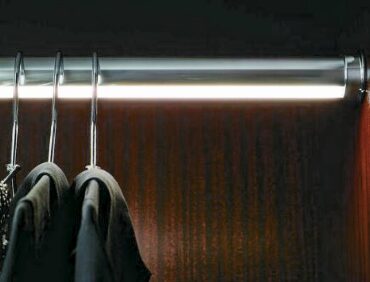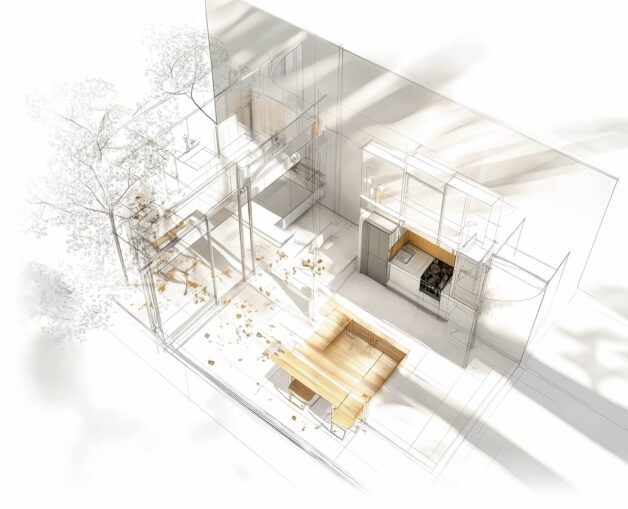 Building and remodeling a home are not inexpensive endeavors. When planning and designing for these investment projects, it’s essential not to overlook the little things because in the end, it’s the details that count.
Building and remodeling a home are not inexpensive endeavors. When planning and designing for these investment projects, it’s essential not to overlook the little things because in the end, it’s the details that count.
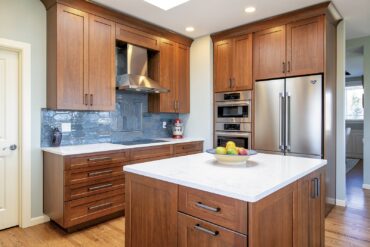
From the onset of the project, after developing a project budget, you need to address three main criteria to achieve a high cost-to-value ratio:
- Low maintenance and high durability (quality products) are always in your best interest. You can pay now or pay later — and paying later will cost more money and time. Most homeowners have better things to do with their time than clean and maintain their homes. It’s also becoming increasingly difficult to find local handy people to fix sticky doors, pressure-wash decks or clean tile grout, so investing in high-durability, low-maintenance materials can ensure that you derive more joy and less stress from home-improvement projects.
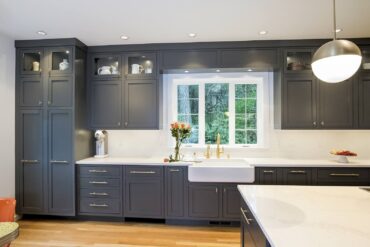
Contemporary farmhouse kitchen with pendant, display, recessed pods and undercabinet lights. Design by McCabe By Design LLC - You can design a beautiful space, but if it’s not properly lit, it’s all for naught. Assessing the lighting needs is imperative — including task, safety, ambient, mood and display lighting — when you are in the planning stage and before construction begins. This step helps ensure your project progresses on time, on budget and with the appropriate lighting levels required for each room’s expected use.
- You need to understand the material specifications requirements, such as height, width and depth, as well as electrical, gas line and plumbing lines, for all materials scheduled for installation. These include cabinetry, plumbing fixtures, windows, doors and, most importantly, appliances.
This article focuses on these three key criteria for four of the most renovated rooms in a home: the kitchen, primary bathroom, primary closet and laundry room (which often doubles as a mud room).
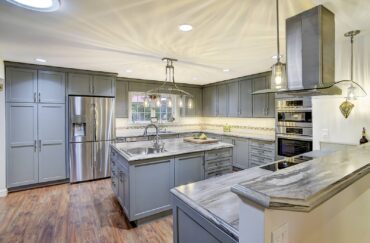
Kitchens
1. Durability and low maintenance products:
Countertops are the workhorse of the kitchen and when it comes to low-maintenance countertops, you have several choices:
- Butcher block with an oiled finish (not recommended for around sinks or cooking surfaces) can be used for prepping food (use a separate cutting board for meats and fish to avoid cross-contamination) and can be lightly sanded and re-oiled periodically to remove cut marks from knives, depending on use. Butcher block also has natural antimicrobial properties.
- Solid-surface countertops, such as Corian and HI-MACS, can be very low-maintenance. If the surface is scratched, scouring powder like Bon Amie or a scouring pad like 3M can typically obscure the scratches if they are not too deep.
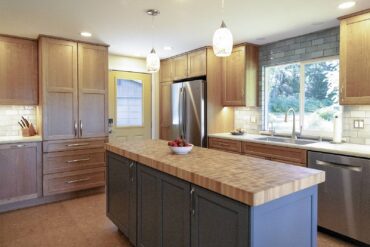
Grothouse end grain maple butcher block countertop. Design by McCabe By Design LLC - Engineered stone (quartz) is relatively bullet-proof and doesn’t require any resealing.
- Quarried stones, such as granite and marble, can be sealed with a sealant after installation (a bit costly) if natural stone is a must for meeting your aesthetic preferences.
Flooring in kitchens is often subjected to a high level of traffic (abuse) from people and pets. Understand not only the maintenance requirements of your chosen flooring material but also the manufacturer’s warranty to ensure that your choice aligns with your lifestyle.
Some considerations:
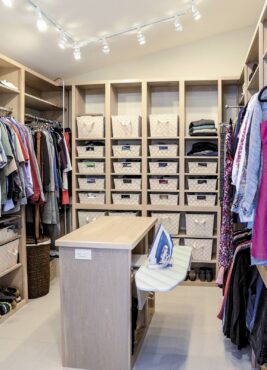
- Nail-down hardwood floors are beautiful and timeless, providing a good return on investment. However, if they don’t receive proper care — such as regular sweeping, removing wet shoes at the door, wiping up spills and avoiding refrigerator models with ice and water in the door (this feature is known for failure and has ruined many a hardwood floor) — they can show wear prematurely. If the flooring extends into other rooms, refinishing can be expensive and inconvenient, requiring the removal of furnishings from the home during the refinishing process.
- Linoleum is durable, low-maintenance and available in a wide range of colors and patterns. It’s perfect for laundry rooms, mud rooms, kids’ bathrooms and kitchens (especially for a period-specific aesthetic for homes built between the late ’30s and early ’60s), depending on your aesthetic preferences.
2. Lighting a kitchen effectively:
Kitchen lighting comes down to good planning and understanding the characteristics of the various types of lighting products (including lighting controls) that are appropriate for your kitchen. Things to consider:
- Kitchen islands and breakfast tables, depending on their size, can benefit from a combination of pendants, chandeliers and recessed can lights, all of which can be operated independently with dimmers. The pendants offer ambient and mood lighting with design flair, while the can lights provide task lighting for food preparation and cleanup.
- Undercabinet lighting provides excellent task lighting, as well as indirect lighting for navigating the kitchen before the sun comes up and after it goes down. Additionally, undercabinet lighting may help mitigate seasonal affective disorder (SAD) by using a low-Kelvin temperature LED tape light or a color corrected temperature (CCT) product.
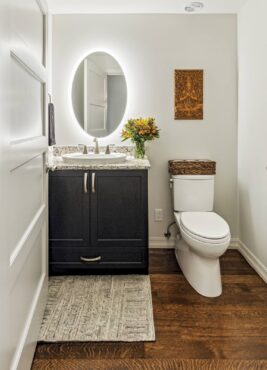
A powder room backlit LED mirror provides perfect all around illumination for guests. Design by McCabe By Design LLC (Photography courtesy Tammy Dwight) - Lighting undercabinet toe kicks or cabinet interiors with glass doors can render a beautiful glowing effect, helping set the desired mood for the kitchen and making it easier to navigate. Cabinet drawer lighting provides homeowners with an enhanced ability to locate food products (reducing food waste) and prep tools with greater ease.
3. Understanding product specifications:
The importance of reading product specification sheets before making a purchase cannot be overstated. Keep this in mind:
- Nearly one in 20 refrigerators are returned to an appliance store because of the homeowners’ lack of understanding that they need to measure the width, depth and height (to the top of the door hinge), along with the manufacturer’s specifications for required air-circulation space around the unit (to minimize voiding the product warranty), only to find out that the fridge they purchased does not fit in the hole their previous fridge occupied.
- When purchasing gas appliances such as a range or clothes dryer, it’s not uncommon for a homeowner to forget to order the natural gas model vs. the liquid propane model, depending on their home’s fuel source.
- When replacing an electric range, older models typically have three-wire pronged plugs. Today’s electric-resistant and induction models typically require four-wire connections.
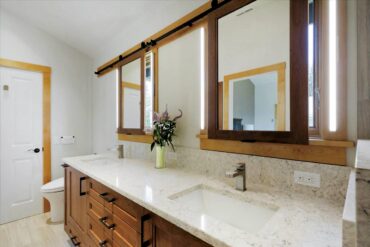
Twiggy LED bar lights mounted on either side of these vanity mirrors illuminate the person using the mirror (positioned over the window) when needed, then slide away when natural light is preferred. - Kitchen ventilation appliances must be sized to the fuel source. For example, an exhaust hood for natural gas and liquid propane ranges should be 6 inches wider than the width of the range or cooktop. The unit’s ability to move air (CFM or cubic feet per minute) should be a ratio of 1 to 100. You need one CFM per every 100 BTUs to maintain the manufacturer’s warranty and a healthy indoor environment. However, most permitting jurisdictions have a code that requires a source of make-up air when the exhaust appliance’s CFM exceeds 400. Note: Most down-draft and updraft hoods are intended to run at 600 CFM. Induction cooking surfaces can be operated safely and within the manufacturer’s warranty specifications with 400 CFM exhaust fans.
- Ordering a garbage disposal with a “pigtail” allows the installation to be “plug and play” vs. having to make a hard-wired connection.
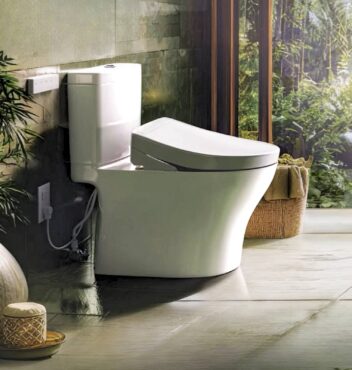
Bathrooms
1. Durability and low-maintenance products:
Bathrooms are damp environments that require nonporous and mildew-resistant materials to look and smell good while being low maintenance. A few recommendations:
- Tile is the floor material of choice for bathrooms due to its scratch resistance, impervious nature and the ability to lay electric-resistant heat effectively under it. From a safety standpoint, a tile floor combined with electric-resistant heat can minimize slips and falls in the bathroom, as floors will dry faster, reducing the opportunity for accidents.
- Plumbing fixtures that are built with ceramic cartridges rather than plastic are less susceptible to failure (leaking) when subjected to hardwater. The name-brand faucet you purchase at a box store is generally not constructed the same way (less durable plastic parts) as the one purchased from a plumbing distributor, hence the price differential.
- No one enjoys squeegeeing their shower glass, but it’s a necessary everyday maintenance task if you want your shower glass to look fabulous for years to come. Shower glass can be treated at the factory to shed scale and mineral deposits (the protective glass product cannot be applied once the glass has left the factory). Alternatively, if you hate to squeegee, consider the AIRMADA, which is essentially a mechanical blow dryer for your shower. This shower-drying system embeds air ports into the shower walls, delivering warm, dry air to the shower enclosure and speeding up the moisture removal and drying of the shower surround, including the glass.
- Large-format tiles with rectified edges and mildew-resistant grout are two of the best maintenance-reducing products on the market. Not only do you have fewer grout lines, but the rectified edges reduce the required width of the grout lines. Paired with grout that has been impregnated with a mildew-resistant formula, these tiles significantly reduce cleaning maintenance requirements. Tip: Never use any cleaning product that is not pH-neutral on your tile grout — these products can pit your grout, creating a perpetual maintenance nightmare.
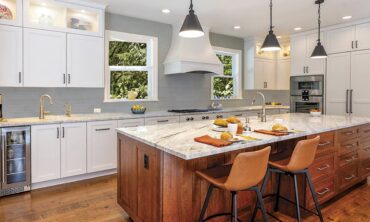
2. Lighting a bathroom effectively:
Lighting for grooming, task lighting for inserting contacts and cleaning the bathroom, ambient mood lighting for a relaxing soak in the bathtub and night lighting all require specific consideration prior to the swing of the first hammer, such as:
- Applying make-up and shaving is easier when you use an LED mirror with a light source that wraps around the whole perimeter of the mirror. Perfect for grooming the underside of a person’s chin, cheeks and forehead with even illumination. Alternatively, placing high-lumen wall sconces close to the sides of the mirror, with a can light centered above the sink, can also provide good coverage.
- Lights centered over the shower, especially with integrated exhaust fans, make bathing and leg shaving safer.
- Low-level undercabinet or cove lighting, activated by an occupancy sensor, allows you to navigate in the dark to the water closet or medicine cabinet without gaining full consciousness from bright lights. Alternatively, electrical switch plates and receptacle plates are available with integrated down lights.
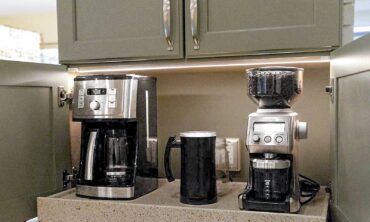
3. Understanding product specifications:
As with the kitchen, the importance of reading product specification sheets before you purchase cannot be overemphasized. What to keep in mind:
- Bidet-style toilet seats and fully integrated toilets typically require a 20-amp, GFCI outlet within 12 inches of the toilet.
- Zero-threshold showers are desired by people of all abilities and ages and enhance a home’s resale value.
- Roman tub fillers come in a multitude of configurations, which requires careful review of the manufacturer’s specifications to ensure all requisite parts are ordered together.
- Wall-hung vanity cabinets are perfect for small bathrooms and those designed for accessibility, provided the depth of the sinks and length of the associated drains and p-traps selected can be accommodated.
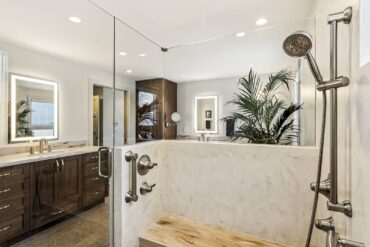
Primary Closets
1. Durability and low-maintenance products:
- Incorporating quality hardware and storage features — such as plywood shelving with veneered surfaces vs. melamine, solidly fabricated closet rods rather than wire shelving with minimal rod support or plastic drawers and storage bins — will not only deliver a longer life but also allow you to customize your closet storage to ensure every inch of space delivers value.
- Instead of carpet, consider hardwood, linoleum or cork flooring in a closet to minimize moisture retention.
- Consider installing an exhaust fan to keep clothes smelling fresher and to maintain good indoor air quality.
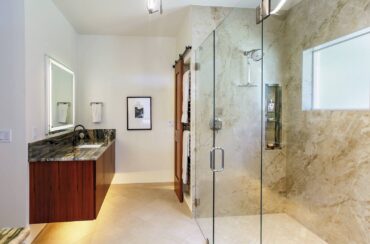
2. Lighting considerations:
Effectively lighting a closet is as important as lighting a kitchen or bathroom. Things to consider:
- Closet code requirements limit the type and placement of lighting fixtures in closets to minimize the risk of house fires. Fixtures with halogen, xenon and exposed incandescent bulbs will likely not pass code (and fluorescent is being completely phased out). Therefore, surface-mounted (either over the closet door header or the ceiling) LED fixtures are the best choice for closets. Remember to choose fixtures that offer 2,700 or 3,000 Kelvin to illuminate the closet contents properly.
- With double-hung closet rods, the lower rod is often in the shadow, making it difficult to see the colors and textures of the clothes. To mitigate this, consider using low-voltage lighted closet rods on the lower run.
3. Understanding product specifications:
Again, the importance of reading product specification sheets before you purchase cannot be overemphasized.
There is a plethora of fabulous closet storage options on the market to help keep a closet organized, which can help make morning routines less hectic — “a place for everything and everything in its place.” However, understanding how each component is installed (and supported — i.e., whether it requires blocking in the wall) is of the utmost importance to ensure a good return on investment.
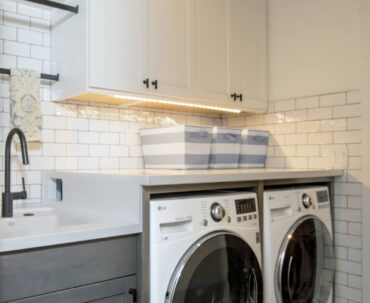
Laundry Room
1. Durability and low-maintenance products:
These are essential for the quadruple, rough-and-tumble duty of most laundry rooms. Considerations include:
- Laundry room countertops are subjected to a variety of messy activities, including wet and muddy clothes, pet grooming, garden starts, crafts and more, so countertop durability is key.
- Laminates are a good choice due to their price point, ease of maintenance and color options. To give them an updated look, consider a decorative edge that conceals the characteristic “telltale” brown edge.
- Solid-surface countertops, such as Corian and HI-MACS, can be very low maintenance and you may be able to obscure scratches that are not deep by using a scouring pad or scouring powder.
- Engineered stone (quartz) is a substantially higher-priced product, but it is relatively bulletproof and doesn’t require resealing.
2. Lighting a laundry room effectively:
- Undercabinet lighting is an excellent choice for task lighting.
- Flush-mount overhead lighting fixtures are both cost-effective and efficient in terms of light dispersion in a laundry room.
3. Understanding product specifications:
The importance of reading product specification sheets before you purchase cannot be overemphasized. Top recommendations:
- Front-loading clothes washers are typically hinged on the left and the hinging cannot be changed (unlike a dryer door), so it’s important to confirm that your water and power connections are accessible for the type of laundry machines you want to purchase.
- All-in-one, stacked clothes washer and dryer units are fabulous, with all the controls located between the washer on the bottom and the dryer on the top. These space-efficient units are perfect for wheelchair users because the washer drum, dryer drum and controls for both are within easy reach. However, to successfully deliver these heavy and awkward units to your laundry room, you will need to measure the access to the laundry room carefully to ensure there is ample space to pivot the unit into place.
The aforementioned tips and recommendations can help you understand the parameters and nuances of selecting and installing common materials and products in a home before you purchase them.
If selecting materials or reading specification sheets is not in your wheelhouse, professional interior designers or building contractors can help you wade through your options and give you constructive advice, effectively streamlining the selection process. You can find these professionals through your local chapter of the National Kitchen & Bath Association (nkba.org) and the National Association of Home Builders (nahb.org).




